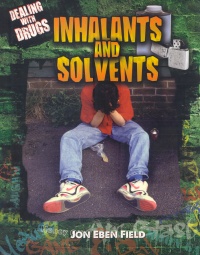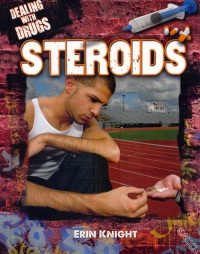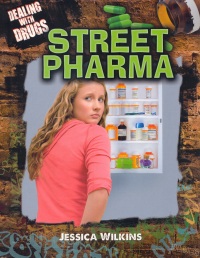| ________________
CM . . .
. Volume XVIII Number 33. . . .April 27, 2012 
 |
Inhalants and Solvents. (Dealing with Drugs).
Jon Eben Field.
St. Catharines, ON: Crabtree, 2012.
48 pp., pbk. & hc., $11.95 (pbk.), $21.56 (RLB.).
ISBN 978-0-7787-5515-9 (pbk.), ISBN 978-0-7787-5508-1 (RLB.).
Subject Heading:
Inhalant abuse-Juvenile literature.
Grades 5 and up / Ages 10 and up.
Review by Joanne Peters.
|
| |
|
 |
Marijuana. (Dealing with Drugs).
Troon Harrison Adams.
St. Catharines, ON: Crabtree, 2012.
48 pp., pbk. & hc., $11.95 (pbk.), $21.56 (RLB.).
ISBN 978-0-7787-5516-6 (pbk.), ISBN 978-0-7787-5509-8 (RLB.).
Subject Heading:
Marijuana-Juvenile literature.
Marijuana-Therapeutic use-Juvenile literature.
Marijuana abuse-Juvenile literature.
Grades 5 and up / Ages 10 and up.
Review by Joanne Peters.
|
| |
|
 |
Steroids. (Dealing with Drugs).
Erin Knight.
St. Catharines, ON: Crabtree, 2012.
48 pp., pbk. & hc., $11.95 (pbk.), $21.56 (RLB.).
ISBN 978-0-7787-5518-0 (pbk.), ISBN 978-0-7787-5511-1 (RLB.).
Subject Heading:
Steroid abuse-Juvenile literature.
Grades 5 and up / Ages 10 and up.
Review by Joanne Peters.
|
| |
|
 |
Street Pharma. (Dealing with Drugs).
Jessica Wilkins.
St. Catharines, ON: Crabtree, 2012.
48 pp., pbk. & hc., $11.95 (pbk.), $21.56 (RLB.).
ISBN 978-0-7787-5519-7 (pbk.), ISBN 978-0-7787-5512-8 (RLB.).
Subject Headings:
Medication abuse-Juvenile literature.
Drug abuse-Juvenile literature.
Grades 5 and up / Ages 10 and up.
Review by Joanne Peters.
***½ /4
|
| |
|

excerpt:
Studies show inhalant and solvent abuse is highest among grade 8 students, but the chemicals huffed or sniffed are not child’s play. Experimenting with inhalants is risky. Users can die – even from the first time they try it. They can suffocate, asphyxiate, choke on their own vomit, or make other thoughtless and reckless decisions that may seem fun when they are under the influence. Inhalants and solvents are highly addictive and cause brain damage and harm vital organs.
Volatile solvents such as gasoline or nail polish remover are the most common inhalants and solvents used by youth to get high. These are liquids that rapidly evaporate at room temperature into vapors, or fumes. The vapors from solvents are inhaled into the longs and users experience a brief, disorienting high. The high may make users feel dizzy, euphoric (extremely happy), nauseous, or giddy. The high ordinarily disappears within a few minutes to half an hour and then some users feel depressed and sad. Many begin inhaling vapors almost immediately to recreate and extend the feeling of being high. (From Inhalants and Solvents.)
Adolescents sometimes respond to concerns about recreational drug use with the question, “What’s the big deal?” But, as the above excerpt indicates, using non-medical substances is “a big deal”. Each of the four books in Crabtree Publishing’s new series, “Dealing with Drugs,” provides up-to-date, clear, and non-judgmental information about marijuana, steroids, inhalants and solvents, and “street pharma” (prescription and over-the-counter medications used for non-medical purposes). Clearly, using and dealing with drugs is a big deal. Although the publicity release for this series suggests that the Interest Level for these books is Grades 5 through 8, I think that the content will work for students in grades 9 through 12, as well. Yes, the books feature a fairly large font size, and there are plenty of photos and other graphic materials, but today’s adolescent reader of nonfiction is used to the text and graphic mash of the Web, so I think that the graphic layout will appeal to them. It may be hard to accept that students as young as Grade 5 may be “using”, but if they are, “Dealing with Drugs” offers an accessible source of information about drug use and abuse, as well as information on drug dependence, treatment for addiction, and seeking help for the problem.
Each of the four books discussed below has a different author, but they share a common format. The books are 48 pages long (available in either library binding or paperback) and are well-illustrated with full-colour, well-captioned photos, informative charts, and interesting pull quotes. The opening page grabs attention with a series of “Facts and Stats” which provides some provocative (and usually, disturbing) information about the drugs and then, follows with a one-page “Introduction” to the drug and its potential for harm. Following the Introduction is a description of the drug, its variant forms, how it is typically used and misused/abused, and its availability (legal/prescribed, or its status as a controlled/banned substance). Subsequent chapters in each book explore the physiological and psychological effects of that category of drug, the drug’s history (and they all have a history!) and, in some cases, the culture that has developed around the drug. Common to all the books are the final chapters: “Dependence and Addiction”, “Seeking Help”, “Treatment and Recovery”, and two pages of “Resources” listing titles of current books for adolescent readers, as well as reliable web-sites. “Organizations, Hotlines, and Helplines” offers a brief listing of Canadian and American organizations which can assist a young drug user to access help. The chapters on “Dependence and Addiction” and “Seeking Help” both acknowledge the difficulties of drug dependence but are non-judgmental in their presentation, recognizing the emotional conflict and physical distress an addict is likely to experience in the process of facing the problem and undergoing treatment. The chapters on “Seeking Help” also reinforce the important role which supportive peers can play in helping a friend who has disclosed or shows signs of drug abuse. The final pages of each book feature a Glossary (unfamiliar words or terms are bold-faced throughout the book’s text and are briefly defined in the Glossary), and a short Index.
The front cover of Inhalants and Solvents shows a young man, sitting up against a wall, head in his hands, a container beside him, and a plastic bag in front of him. He’s just “huffed” the product in the container. His age is indeterminate, but he could be as young as 13 – the “Facts and Stats” state that “the highest rate of inhalant and solvent abuse is found among grade 8 students.” Why? Probably because there’s easy access to the over two thousand household products that can be used (and abused) in this fashion. The news media may report cases of gasoline sniffing on First Nations reserves in Canada’s north, but suburban homes and garages offer middle-class kids an array of equally dangerous substances: spray paint, pressurized food products, such as whipping cream and non-stick spray, and of course, that old standby, nail polish remover. Even the classroom isn’t immune: felt-tip markers and liquid erase products contain fumes from solvents such as toluene. Clearly, there’s plenty of “poor man’s pot” around, and the consequences of using it can be any variant of SSDS (sudden sniffing death syndrome): suffocation by plastic bag, asphyxiation from the inhaled vapors, or noradrenaline flooding, leading arrhythmia and a sudden cardiac arrest. If nothing else, the user can become reckless, and risky behaviour ensues For those users fortunate enough to stop and avoid permanent brain damage, there is treatment, but it often has setbacks and relapse is not uncommon.
Sadly, “inhalants and solvents are considered ‘gateway drugs’ because many users graduate to using other drugs -- ones that give them a longer or more intense high – when huffing no longer works. (Inhalants and Solvents, p. 13). When huffers move on, their next choice will probably be marijuana, “the most commonly used illicit drug in the world.” (Marijuana, p. 4) Although the “Introduction” to Marijuana is entitled “Reefer Madness?” (a reference to the famous 1936 anti-marijuana scare film which has since become a cult classic), the intention of this book is certainly not preachy, anti-pot propagandizing. It acknowledges the reality that smoking marijuana is perceived as “relaxing and harmless”, that it has a cool rep (actors and musicians use it), and, as a plant-based substance, how harmful can it be? Of course, plants can contain dangerous compounds, and in marijuana, THC (its levels steadily rising as weed growers work to provide a stronger high) and other cannabinoids have powerful effects on the nervous system, while the lungs are damaged by the inhalation of three to five times the level of carbon monoxide present in cigarette smoke.
Notable in this book is its discussion of “Cannabis and Culture”: the popularity of “stoner movies” - comedies depicting recreational drug use as little more than a silly indulgence -, the media attention given to “celebrity stoners”, and, of course, the ongoing lobby to legalize or decriminalize recreational use of marijuana. The ugly realities of marijuana addiction, along with the uglier reality of the violent role of organized crime in marijuana’s provision and marketing, are anything but glamorous. The consequences of being a “pothead” are explained in terms that high school readers can understand: as an athlete, THC will affect co-ordination, balance, or reaction time; as a student, it’s harder to remember, retain, and retrieve information; finally, psychomotor impairment makes driving any vehicle or operating machinery a very risky business. On the positive side, most pot addicts can quit weed without undergoing life-threatening symptoms, of which the most serious is profound depression (and even that outcome is usually treatable).
While marijuana impairs athletic ability, steroids are “ergogenic” and can improve athletic performance. Whether an athlete wants to improve endurance (the ability to train hard and recover quickly), or strength (“bulking up”, so as to be muscular), Steroids explores the reasons for taking the risks involved in the misuse of this type of drug The desire for improved athletic performance has a long history: ancient Greek athletes prepared for their Olympic competitions by imbibing dangerous combinations of wine, strychnine, and hallucinogenic mushrooms. Today, the rewards of celebrity status enjoyed by high-profile amateur and professional athletes have led to numerous accusations and admissions of “doping”. But, it’s not just improved athletic performance which leads to steroid use; young men want that “ripped”, “six-pack” that can only be had by using something to improve their physique. Growth hormones and nutritional supplements are popular and can be purchased on the ‘Web or at a gym or fitness centre. Steroids recognizes that high school athletes face pressures: the desire to make the team, or more desperately, the need to nail that all-important athletic scholarship or placement at the university of their choice. Unfortunately, adolescents, their bodies in a state of ongoing development, are particularly vulnerable to the affects of steroid use. Psychological affects include mood swings and loss of emotional control; teen suicides resulting from steroid use can be attributed to the overwhelming depression suffered in the “down” phase of mood disorders. Physiological disorders cover a wide range, many of which are long-term, irreversible, and can lead to organ failure, and premature death.
Although ergogenic drug users often obtain their drugs through black market sources (trainers and coaches who are willing to “deal”, despite the ethical and legal issues of doing so) or through online sources, some manage to convince their personal physicians that they need their drugs for some medical reason. Street Pharma makes it clear that prescription drugs and over the counter (OTC) medications can also be a source of drug abuse. Just as plant-based substances (e.g. marijuana) can be harmful, prescription drugs can be just as dangerous as any street drug. When a doctor writes a prescription, he or she makes a careful consideration of the patient’s physical condition, as well as the medical condition necessitating the drug. However, “using meds you don’t need is just as dangerous as using street drugs.” (5, Street Pharma, p. 5)
Why would anyone take medications that they don’t need? Some kids do so purely for experimental reasons, while others take meds to get high, to relax, to stay awake while studying, or to numb some kind of pain, either physical or emotional. And, the fact that the prescription hasn’t been written for the user is no barrier: some teens raid the family medicine cabinet, some steal meds from friends or relatives, and some buy on the street from someone who is “dealing” the stuff illegally. Of course, the local pharmacy or supermarket is another ready source for OTC medications. However, lest anyone think that either prescription or OTC medications are not without their dangers, a two-page table lists drug types, their street name, recommended uses, and general effects. (Street Pharma, pp 13-14) Depending on the drug’s intended effect, upping the dosage or combining them with other drugs and alcohol can lead to physical or psychological addiction, and in the worst of cases, death. In Street Pharma, the message is clear: if it’s not your prescription, don’t take it, and if you do, don’t mess with the dosage directions.
The “Dealing with Drugs” series does an excellent job of providing a concise but comprehensive overview of drug abuse. My only complaint is the lack of source references for the “Facts and Stats” pages. Although the facts and stats information is undoubtedly valid and reliable, students need to be reminded that it is important to know the original sources of any fact-based information. Middle and high school libraries can never have enough readable, reliable, and current information on this topic, and, as such, the “Dealing with Drugs” series is an affordable addition to both middle and senior high school library collections. Guidance and counseling staff will also find the books to be especially helpful resources for their student clients, as well as useful background material for other teachers whose students are abusing drugs. Still, some adults may find the content of some of the books to be a bit disturbing (the “they wouldn’t think of using this stuff if the information wasn’t available” argument), so be prepared with a rationale for placing the books in the collection, especially at the middle school level.
Highly Recommended.
A retired teacher-librarian, Joanne Peters lives in Winnipeg, MB.

To comment
on this title or this review, send mail to cm@umanitoba.ca.
Copyright © the Manitoba Library Association. Reproduction for personal
use is permitted only if this copyright notice is maintained. Any
other reproduction is prohibited without permission.
NEXT REVIEW |
TABLE OF CONTENTS FOR THIS ISSUE
- April 27, 2012.
AUTHORS |
TITLES |
MEDIA REVIEWS |
PROFILES |
BACK ISSUES |
SEARCH |
CMARCHIVE |
HOME |



